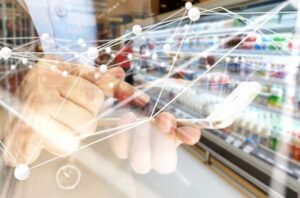A year ago there were two grocery shopping channels: offline and online. Today we find ourselves with an omni-hybrid model where multiple channels are serving and competing in similar and increasingly intertwined functions. In addition to the convergence of offline and online that most are familiar with, now wholesalers, restaurants, and even CPG brands are beginning to cross swords where they never did so in the past. As we move from full-on lock-down to what most believe will be a long stretch of uncertainty, grocers need to contend with this strange new and nebulous normal by shoring up their data capabilities and adjusting their user experience norms. Where shall we begin?
Well, everyone knows about the most obvious convergence—the one between online and offline. Before the pandemic, online grocery was for computer-savvy 18-35 year olds while traditional stores were for everyone else. If the two channels intermingled at the fringes, it was not by much. Thanks to COVID-19, new users from every demographic piled online to order from the safety of home, leading to a five-fold shift in market share. As a result, online grocers have become primary shopping sources, competing with brick-and-mortar stores for customers of all generations.

That’s not the only line being blurred by the times, though. During the crisis, food wholesalers who normally sell to restaurants opened up direct-to-consumer bulk provision of eggs, meats, fish, and produce, competing with bulk retailers like Sam’s Club and Costco. Shuttered restaurants began selling everything from flour to toilet paper, as customer demand overwhelmed traditional grocery channels.
Meanwhile, the existing blurred lines between dine-in restaurant service and prepared food or grab-and-go offerings of groceries has reached a fevered pitch. You might conjecture that some of this channel convergence was a real anomaly—desperate measures cooked up by embattled businesses for the short term. You could be right. Only time will tell. But there’s another odd convergence that’s come about which might be even more worrisome for grocers. I’m talking about the trend of consumer packaged goods brands selling direct to consumer (DTC). Following in the footsteps of everything from eyeglass companies like Warby Parker to DNA testing like 23andMe.com, consumer brands are now dabbling with endpoint sales to the folks who normally consume their products anyway. Just look at Frito Lay’s snacks.com, where grocery shoppers can have everything from Lay’s classic potato chips to Rice-a-Roni to Captain Crunch breakfast cereal shipped directly to their door, with a minimum order of just $15.00, and free shipping. It isn’t just the PepsiCo family, either. We have seen DTC entrants from brands as diverse as Heinz, KitKat, and Clorox emerge since the beginning of the crisis.
But hold on there. It’s not the end for traditional grocers, nor for their online counterparts. Far from it.
How can conventional grocers possibly compete with that? Are we seeing the beginning of the likes of what iTunes did to Tower Records and Amazon did to the neighborhood bookstore? Will DTC wholesalers like Public Goods and DIY meal kit services like Hello Fresh take a bite out of the traditional grocery supply chain the way that Dollar Shave Club disrupted personal care a few years ago? The answer is “yes,”—if buying somewhere else truly feels more convenient and natural to the consumer than buying from you.But hold on there. It’s not the end for traditional grocers, nor for their online counterparts. Far from it. In fact, this might just be the wake-up-call that the grocery industry needs to begin taking the new paradigm of personalized customer service seriously. Look, data and AI-driven personalization is already a relatively mature approach in general e-commerce. When you go to buy a book, a set of earphones, or a new dining room set, you can be sure that the internet has you drilled down to a tee. The likes of Amazon, Best Buy, and Overstock have been tracking, buying, and parsing data about you for years. They know who you are, what you like, and how you buy…seriously. When you log on, you see only what you want and exactly what you want, every time.
We are not—I repeat, NOT—going back to the old normal
Where has grocery been all this time? I’m calling out every CEO, CTO, and CMO in the grocery industry. Ladies and gentlemen, our time has come! Those memes on the internet that say “if you’re waiting for a sign, this is it”…those are for you. Don’t be the ones who say “everything will go back to normal soon.” It won’t. We are not—I repeat, NOT—going back to the old normal.

Not this quarter, not this year, not this century. The future has arrived. Get on board now, or be left behind!They tell me I only get about 1,000 words to speak my piece in these articles. And the discussion of what grocers should do in these strange and interesting times requires more than the eight minutes it takes to read a post like this. But I don’t want to be that guy who points out all the problems and then drops the mic without offering any solutions, so let me break it down to something relatively simple:If you are a grocer today and you are looking to make the right moves for the future, the one thing I want to suggest is that you take control of your customer relationships today. How? From this moment forward, I want you to focus a great deal of your energy, talent, and budget on personalizing your customer experience. When a shopper returns to your site or your scan-and-go app, you need to know their preferences as well as you currently know your own merchandise. Are they vegetarian? Do they shop for themselves, or for a family of five? Are they open to personalized recommendations of imported foodstuffs, or do they strictly buy the same shopping list every two weeks? If the latter, what is it? What do you do when their favorite items are out of stock? How can you help them find what they need more conveniently? And how can you help them discover the delicious foods that they didn’t even know you carried?
Your advantage is data.
What it comes down to is this: You have one chance—ladies and gentlemen, that chance is right now—to convince your customers that you are the right grocery shopping choice for them. In the year 2020, there is simply no excuse not to know your customer as well as if you were a corner bodega shopkeeper in a tiny neighborhood. You need to establish the digital equivalent of the neighborhood relationship that existed between seller and buyer 50 or 100 years ago, or else they will go and buy from someone who does that better.Your advantage is data. You are sitting on a goldmine, which is waiting to be used for the benefit of both grocer and shopper. If you don’t throw resources into this now, you will never have the chance to do so again. I don’t mean to be alarmist. There is still time. But I do firmly believe that history will look back at this moment as the turning point in grocery shopping. And I want you to be one of those who saw it, took advantage of it, and made it all work for you. It seems my 1,000 words is up. We established Halla to help grocers use food shopping data better. Please feel free to contact me if this spoke to you.

